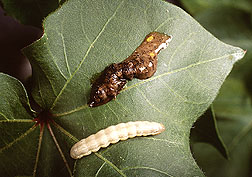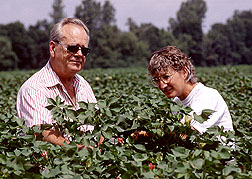Biological Warfare Against Beet Armyworms
|
|
Beneficial insects are often victims of "friendly fire" when farmers spray insecticides to battle crop-damaging beet armyworms.
But now, a more selective approach is in the works at two Agricultural Research Service labs in Mississippi. Scientists there are recruiting two of the armyworm's most formidable natural enemies, and it looks to be a grisly affair.
One recruit is a natural insect pathogen known as a Spodoptera exigua nuclear polyhedrosis virus (SeNPV). It liquefies the bodies of armyworms it infects but poses no danger to humans, animals, or helpful predators like big-eyed bugs, which eat other crop pests.
The SeNPV organism is also harmless to the scientists' other recruit: Cotesia marginventris,a wasp that parasitizes armyworms.
Exploiting the virus as a biological control agent is the goal of entomologists Randy Bell and Doug Streett, who are at the Agricultural Research Service Southern Insect Management Research Laboratory in Stoneville, Mississippi. In nature, the SeNPV virus inhabits the soil. But the researchers showed it can be formulated and sprayed onto cotton plants as a so-called biopesticide.
When they tested the approach in field studies, about 60 percent of armyworms died within 4 days of chewing on the virus-treated plants.
|
|
Once ingested, the virus replicates millions of times inside the worm's body, turning the pest's tissues into a dark, slushy mess.
"These particular pathogens are very host-specific and kill rather quickly compared to other NPV," says Bell, who is retired but serves as a consultant at the Stoneville lab.
This summer, another round of field studies on cotton is planned in collaboration with Dupont Chemical Company scientists. Of particular interest will be use of a feeding stimulant to ensure worms get an unhealthy dose of the lethal virus.
Meanwhile, about 130 miles east, entomologist P. Glynn Tillman is perfecting techniques for rearing the Cotesia wasps and other helpful parasites at ARS' Biological Control and Mass Rearing Research Unit located near Starkville, Mississippi.
Tillman envisions unleashing Cotesia to attack armyworms that plague greenhouse-grown crops. This would help growers save on insecticides and costly, uncomfortable protective gear that must be worn to apply the chemicals indoors.
Like the SeNPV virus, the wasp also depends on the armyworm to further its own reproduction and survival. After mating, a female Cotesia can lay eggs in 30 armyworms a day, and once parasitized, the caterpillars are as good as dead. Within days, they become a nutritious meal for hungry wasp larvae that hatch from the eggs. After emerging from their hosts, the larvae spin a cocoon, pupate, and become adult wasps.
Armyworms sometimes evade chemical sprays by hiding beneath plants' leaves. But they may not be so lucky when a parasite like Cotesia is released. "That's because the wasps will actually go to where the pests are," says Tillman. — By Jan Suszkiw, Agricultural Research Service Information Staff, 6303 Ivy Lane, Greenbelt, Maryland 20770, phone (301) 344-2173.
P. Glynn Tillman is in the USDA-ARS Biological Control and Mass Rearing Research Unit, P.O. Box 5357, Mississippi State, MS 39762; phone (601) 323-2230, fax (601) 323-0478.
Randy Bell and Doug Streett are at the USDA-ARS Southern Insect Management Research Laboratory, P.O. Box 346, Stoneville, MS 38776; phone (601) 686-5231, fax (601) 686-5421.
"Biological Warfare Against Beet Armyworms" was published in the January 1998 issue of Agricultural Research magazine. Click here to see this issue's table of contents.








